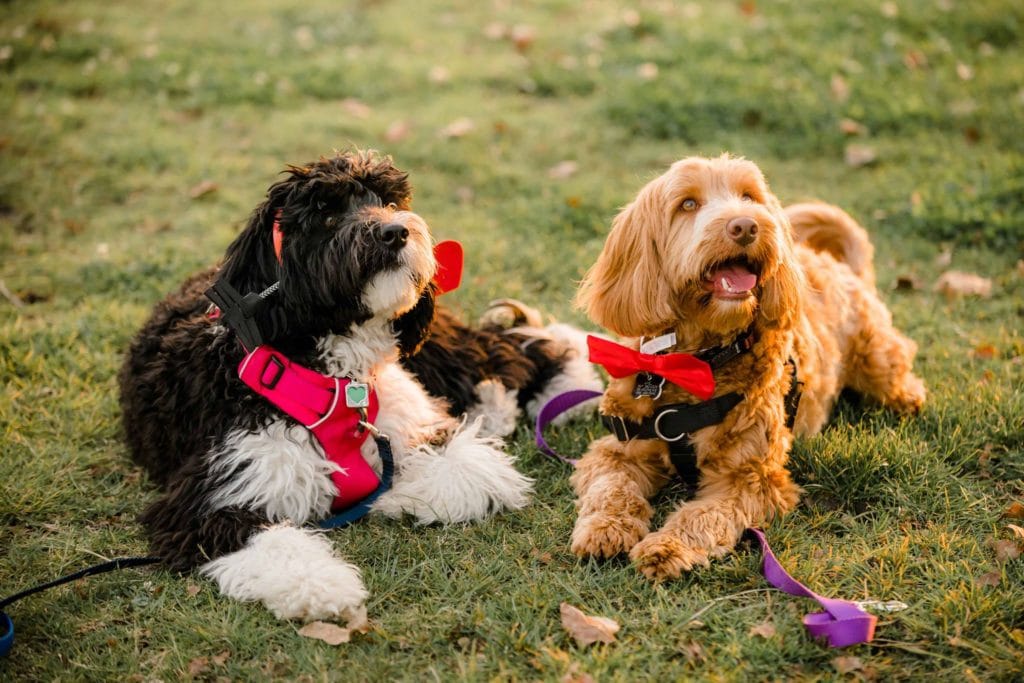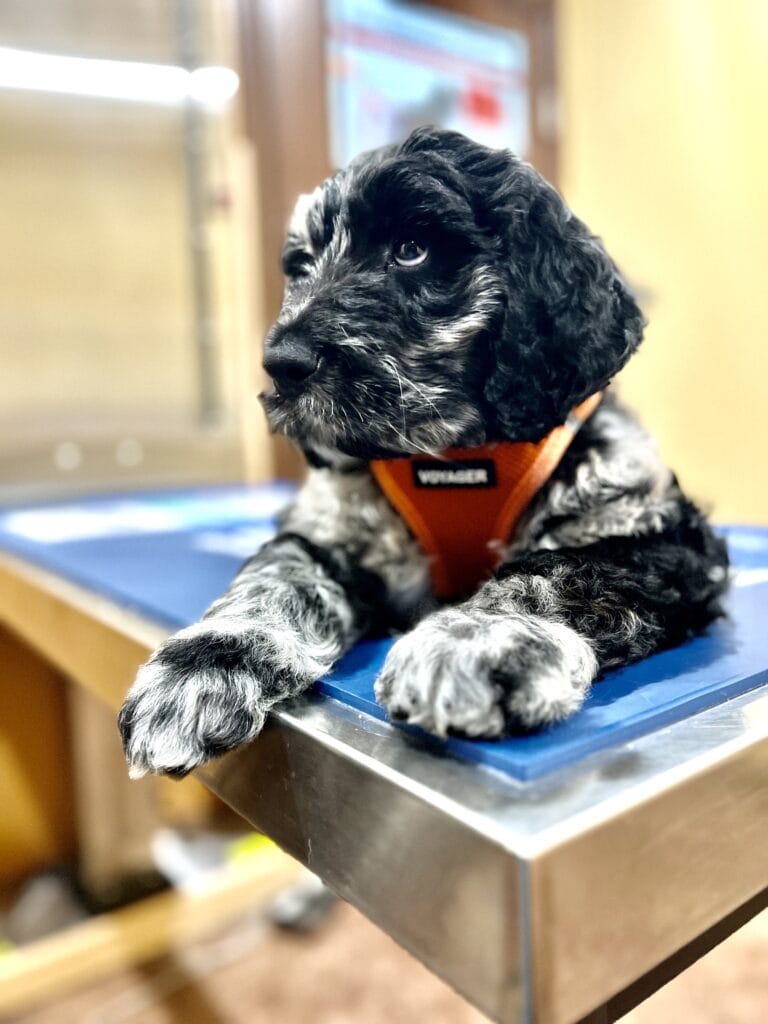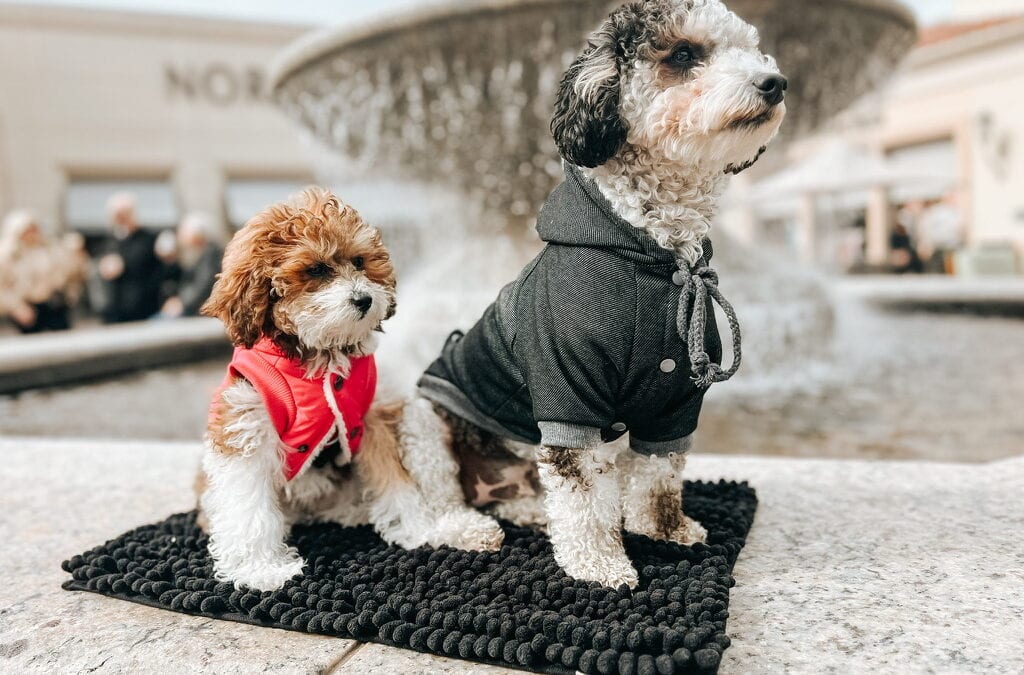The most important training for your puppy that no one is talking about…
It is how to become your puppy or dog’s most trusted person.
You were sometimes referred to as ‘relationship’ or maybe known as creating a ‘secure attachment figure’ with your puppy.
Nurturing an unbreakable bond is the number 1 most important training for your puppy or dog, but it’s not being spoken about in your puppy class!
Having a great relationship with your puppy is the difference between a dog that goes ‘self-employed’ in teenagehood/adult years or a dog that looks to their human for guidance and reassurance – and typically stays out of ‘trouble’.
The World Through the Eyes of Your Puppy

They are 8-12 weeks old, and they’ve been taken away from their mother, who, up till this point, was their place of safety, food, warmth, and comfort. The world is pretty big, after all when you’re a pint-sized pup. It’s full of sights, sounds, smells, places, people, dogs, and experiences, with much to learn about.
This is why socialization is critical – when done right.
Based on temperament, genetics, breed, etc., you have some dogs who are chilled and confident from the beginning. These puppies you take somewhere new, and they’re unphased. They step out boldly and explore easily.
However, the majority of puppies will be tentative and cautious. These pups need more support because they want and need to know that, at that moment, they are safe and nothing wrong or scary will happen to them. Even if the place looks safe to us, it may not always seem that way to your puppy, who is exploring for the first time.
Imagine you go away on vacation and land in a new country where you don’t speak the language and the culture is vastly different. How would you feel?
Vulnerable? Cautious? Excited?
Now consider you’ve got a local translator to lead the way – you’ll probably rely on them to show you around so you can find your way as you navigate this new place.
You are the translator for your puppy, and the new skill you need is to communicate with this other species (dogs) when there is no common verbal language.
Training a puppy or dog is easy when you are in a safe place, and they are looking to you for information because they trust that you’ll take care of them and you have the canine communication skills to build strong foundations.
How to Create Trust and a Secure Attachment with Your Puppy

Talking ‘Dog’
Dogs communicate with each other and with us using body language. They use subtle changes in their body, such as a tongue flick or movements like a head turn to signal what they need at that moment.
The ‘need’ for that puppy, maybe that they want more space from a person, object or dog if they’re feeling a bit unsure, for example. In this case, they may turn their head away, flick their tongue or show the whites of their eyes.
Or it could be a dog’s way of saying that they enjoy the ear tickle or butt scratch and would like it to continue. For this, they may lean in, nudge your hand, or even paw at you to invite the interaction to continue.
Paying attention to what our dogs say with their bodies and responding appropriately allows them to feel heard and understood. This gives them a sense of safety and relief because they get their needs met and know you understand what they are saying. You are speaking the same language.
CLICK HERE for the Dog Language illustration from Lili Chin for more information on understanding your dog’s body language.
Play
Dogs love to play!
When the game includes you, it’s a fantastic way for your dog to learn that you’re a great person to be around you are fun to hang out with and build a relationship with.
Puppies and Dogs will have their unique version of how they play, which will vary based on differences in temperament, genetics, breed specifics, etc.
We can understand how to play appropriately with your puppy by listening to their body language.
They may invite you to play by bringing a toy or grabbing onto an object that is moving, and naturally, they may begin to pull or tug on it. (a lot of puppies do this with loose clothing!)
Some puppies love to tug; others love to tug and win the toy and then walk around with the toys (imagine a spaniel parading a slipper that they show you but don’t give it to you easily).
Others may enjoy the chase of the toy, not necessarily the grab and tug.
Some puppies love to play without toys and will roll about and wrestle with you.
If at any time the puppy isn’t enjoying the game, it may walk away to leave the interaction and sniff the ground. In some cases, a puppy or dog may get a bit more vocal if they are frustrated because they never ‘win’ the toy; in this case, you may start to hear growling.
By observing your puppy’s body language when you play, you’ll start to see what part of the game they love the most. For example, if you stop, do they bring the toy straight back to start the game again?
Remember, it can take time to learn how to play together in a way that you both enjoy, and with patience, you are creating fun and joy – a great way to build trust and a common language.
Safety

Your dog wants and needs to know they are safe. We can’t predict or control what they understand to be scary or unsafe, but when we listen to their body language, we can hear them when they know they are worried about that situation.
When a dog or puppy is feeling scared or worried, depending on their breed or temperament, they may choose different ways to respond.
Some dogs prefer to take control of the situation themselves; if they feel threatened or scared, they may growl, bark, or lunge toward what they are concerned about to make it leave or move away.
Other dogs may choose a different route and prefer to hide, take shelter and make themselves small to signal that they are not scary or threatening in an attempt to diffuse an interaction.
Building Trust
When you have a dog that trusts you, and you are their secure, safe person – these dogs will respond to the information you give them, such as a verbal cue – this could be telling them “let’s go” to indicate to them that you are walking in the opposite direction and you want them to follow you.
For example, if your dog has let you know with their body that they feel unsafe, one way to respond would be to acknowledge how they are feeling and give them space from what they are worried about.
More specifically, this could be when you’re out on a walk, and let’s say your dog is worried about another dog walking toward you. Your puppy has let you know they are worried about the approaching dog because its body becomes stiffer, its ears are raised, and perhaps its tail is straight and still.
This is the first step in their body language telling you they are alarmed and alert. You can support your puppy in this situation by taking a different route so your dog doesn’t have to interact with the situation they feel threatened by.
Imagine the dog going, “Phew! I’m so glad my human isn’t making me walk near that scary object.”
Every time the dog or puppy has that experience, they learn that they are being listened to because they don’t need to interact with the approaching potentially scary thing (possibly the oncoming dog), trusting in their person to take them away where they can feel safe and secure.
Positive Reinforcement Training

Your training method will have a big impact on creating trust and secure attachment with your puppy.
Here at Canine Learning Academy, we use only Positive Reinforcement based training. This means we use rewards and clear information to our dogs to teach them skills and good behaviors.
In its simplest *people-y way*, we like to be with others who are fun and engaging to be around. We respond positively to getting something right and being rewarded – dogs are the same!
As we’ve already discussed, communication is essential in creating trust because it creates a familiar voice between two species that don’t share a verbal language. This means that we need to create alternate ways of ‘talking’ to our puppies and dogs in a way that they understand, and that’s where positive training comes in.
Using Positive Reinforcement Training
We can teach our dogs to understand physical cues, using our bodies and verbal cues, and use sounds with our voice to provide information.
An example of a verbal cue would be to say ‘sit’, indicating the dog to put its butt on the ground.
Or an example of a physical cue may be that I use my hand to indicate a direction for the dog to move, such as sending the dog to go to their bed or to a mat.
Using rewards in our training, we teach our dogs valuable skills for navigating everyday life and creating positive associations.
Like sit and wait while I get your breakfast ready, or sit and wait before jumping into the car to go for a walk.
Every time we reward a behavior, we are more likely to see it occur again because it has been positively reinforced.
Examples of rewards we can use for dogs are food and toys.
We teach our puppies to listen or look for the cue, perform a skill, and receive a reward for getting it right. The more valuable skills we teach, the more common language (cues) our dogs understand, and the more ‘conversation’ we create.
And as discussed in this blog, when we create more opportunities for building language with our puppies, we are helping to create understanding and trust.
Avoiding Punishment
Where Positive Reinforcement creates language and builds trust, punishment can break it.
Some examples of punishment may include spraying water bottles, prong or shock collars, using force, physically hurting, hitting dogs, collar/lead pops or checks, or verbal “Ah ah’s” with the intent to stop a dog from doing something.
We believe here at CLA that it is kinder and more effective to teach our dogs what we DO expect them to do, rather than punishing them for doing things we don’t want or when they get something ‘wrong’.
Punishment of any kind is a Fastrack route to breaking trust.
We are responsible pet parents showing our dogs how to interact with the environment and be a dog in the human world.
Dogs are a perfect example of getting their needs met. For example, a hungry dog may be more likely to steal food off the counter unless we teach them manners around food.
Or a dog that wants to get to the park may pull hard on the leash to get there quicker unless we teach them to walk nicely on a lead.
All of these things can be taught really effectively with positive reinforcement training.
However, anytime that punishment is used, it causes harm, confusion, stress, pain, discomfort, or anxiety to the dogs because often, they are not clear on what causes the punishment to happen.
Imagine you are hungry and you see some food available, so you grab it only to be met by a hard tap on the nose. Now you are hungry, you’ve seen food, and you are also hurt by the human you spend time with. How confusing!
Every time a puppy or dog experiences some punishment, they are actually going to become more suspicious and cautious of the source of the pain or discomfort and more likely to avoid it in the future. When punishing a puppy or dog, you teach them to avoid you. You are creating the opposite of a secure attachment, and you will create suspicion.
In Summary
To create a secure attachment and trust with your puppy, the essential component mentioned throughout this blog is communication.

Our top tips for creating a great relationship with your puppy or dog are:
- Acknowledge the canine body language so your puppies and dogs are being listened to.
- Create a common language and method of communication using positive reinforcement training.
- Have fun, play, laugh, wrestle, and be silly together.
- Appropriately socialize your puppy for positive exposure to novelty and real-life environments for a confident teenage and adult dog.
- Teach the essential skills for navigating the human world, such as walking on a loose leash and returning when called.
- Avoid the intentional use of any punishment, pain, harm, or discomfort.
When you have a puppy that knows to trust its human caregiver, you have built solid foundations from which all training can begin, communication, a beautiful relationship, and avoiding behavioral problems showing up later in life.
GOT A NEW PUPPY?
Congratulations!
Bringing home a new puppy is a huge responsibility! One of the most important things you can do is ensure your puppy develops good behavioral, social, and physical skills. How you train your puppy can dramatically shape their personality and future.
We offer a variety of services to help support your goals and lifestyle.
Over the last several years, we have coached thousands of new puppy pet parents and provided in-home boarding & train for hundreds of new puppies as young as 7.5 weeks.
We understand how important it is to get it right from the beginning.
We specialize in young puppies raised to live in the city or to be working service animals.
Book a free discovery call to discuss the best option for you.
Ready to dive into your positive training journey with your puppy? Check out our Puppy Group Classes, taught in-person in Huntington Beach and virtually (Click Here)
Book a Call with our Certified Dog Trainers, who specialize in young puppy training.
Click Here and speak to Julie Fryman or Yo Armendariz.

